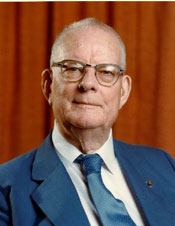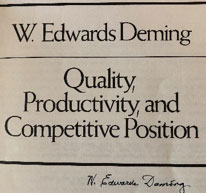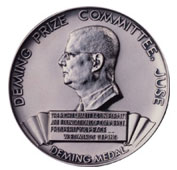December 2018

This month’s publication takes a moment to remember Dr. Deming on the 25th anniversary of his passing. In this issue:
- A Look Back at Dr. W. Edwards Deming
- The System of Profound Knowledge
- The Fourteen Points
- The Seven Deadly Diseases
- Summary
- Quick Links
Please feel free to leave a comment below. You can download a pdf copy of this publication at this link.
A Look Back at Dr. W. Edwards Deming
Google “Dr. W. Edwards Deming.” You will see a lot of links. The top two are usually from Wikipedia, the free encyclopedia, as well as The W. Edwards Deming Institute.
I first heard about Dr. Deming in 1984. I was attending a seminar on Statistical Process Control (SPC) as the company I worked for was embarking on a Total Quality Management (TQM) process. The four-day seminar was built around SPC but had a few hours on the philosophy of Dr. Deming. There were several videos that they showed. One, “If Japan Can, Why Can’t We?”, delivered a powerful message. It was produced by NBC News in 1980 and is widely thought to have started the quality revolution in America. And most importantly, it introduced the methods of Dr. Deming to America. This documentary showed how Japan captured the world-wide automotive and electronics markets by following Dr. Deming’s teachings. In 1980, the vast majority of American managers had never heard of Dr. Deming. On the other hand, the most coveted industrial prize in Japan was the Deming Prize – named after Dr. Deming. And that award has been in place since 1951.

A timeline of Dr. Deming’s life – both personal and professional – is given on the Deming Institute website. A few highlights are given below.
Dr. Deming was born in Sioux City, Iowa on October 14, 1900. His degrees were:
- B. S. in Engineering from the University of Wyoming in Laramie (1921)
- Master’s degree in Mathematics and Physics from the University of Colorado (1925)
- Ph.D. in Mathematical Physics from Yale University (1928)
Several places he worked had an influence on his later methods.
- He worked at Western Electric’s Hawthorne Works in Chicago while in graduate school. This was during the time the Hawthorne Experiments were being done. The company had commissioned a study to see if its workers would become more productive in higher or lower levels of light. This study led to the term “Hawthorne Effect.”
- He met Walter Shewhart, the father of statistical process control, in 1927. Dr. Shewhart had a great impact on Dr. Deming’s future teachings, with understanding variation being one of the corner stones of his system of profound knowledge.
- He worked with the U.S. Census Bureau prior to World War II where he used statistically-based survey techniques to improve the accuracy and lower costs of the 1940 census.
- During WWII, he worked as a consultant to the Secretary of War. He also taught 2000 people at Stanford in how to use the PDSA cycle – an improvement methodology.
Following the war, Dr. Deming worked with several governments including Japan, Greece, and India. It was his work in Japan that caught the attention of NBC News in later years. His first trip to Japan was in 1946 when he was sent by the War Department to study problems related to agriculture. His trip in 1947 was to work with Japanese statisticians in several areas, including a census to be taken and nutritional and housing issues following the war.
The following is a key to how Dr. Deming helped Japan and is taken from The Deming Institute timeline:
“Unlike other American experts brought to Japan, Deming shows respect for the Japanese people and their culture; he treats them as colleagues instead of vanquished enemies.”

Dr. Deming continued to work with other countries and organizations over the years, including Germany, Mexico, Turkey, and the United Nations. He was not completely forgotten in America. In 1955 he was awarded the Shewhart Medal by the American Society for Quality Control (now ASQ).
Dr. Deming received an amazing award from the Japanese in 1960. Again, from The Deming Institute website:
“Awarded the Second Order Medal of the Sacred Treasure by the Emperor of Japan. Emperor Hirohito decorates Deming with an award recognizing the philosophy and methods he provided to Japan, which allowed the nation to rise from destruction to the ranks of world economic power. Three decades later, when asked how he felt on receiving this honor, he says he felt “unworthy.” “I was lucky,” he says, showing he considers himself no exception to his own teachings about the effects of the system upon individual performance.”
Dr. Deming continued to consult/teach in England, France, Taiwan, Argentina and takes a seventh trip to Japan in 1965. In 1975, Dr. Deming retired from teaching.
His “retirement” was short-lived. In 1980, NBC showed their documentary “If Japan Can, Why Can’t We?” and Dr. Deming began to receive the attention he deserved in America. At 80 years old, he began to teach his four-day seminar through the United States and the world. He published more books including Quality, Productivity and Competitive Position and Out of the Crisis in the early 1980s. Dr. Deming presented his 14 points for management in those books. During the 1980s he received multiple awards including the National Medal of Technology, presented by President Reagan. In 1993, he published his last book The New Economics, where he presented in detail his system of profound knowledge. Dr. Deming passed away on December 20, 1993 in Washington, DC.
The System of Profound Knowledge

- Appreciation for a system
- Knowledge of variation
- Theory of knowledge
- Knowledge of psychology
The four parts are interrelated and are introduced below. There is a four part series on the System of Profound Knowledge on our website.
Appreciation for a System
The first part of profound knowledge is understanding what a system is. The following is an excerpt from Part 1 of our publication on the System of Profound Knowledge.
Dr. Deming defined a system as “an interconnected complex of functionally related components that work together to try to accomplish the aim of the system.” Most people familiar with Dr. Deming will remember this as the system shown in the figure below. Thus, suppliers, customers and the organization must work together to accomplish the aim of the system.
All companies and organizations can be part of a system. A system does not just automatically exist. Sure, the relationships shown in the figure exist for all organizations in terms of flow of products and services, but that does not make it a system. The key to understanding a system comes with realizing that there must be an aim, i.e., a purpose of the system. Without a purpose, there is no system. This is really Point 1 of Dr. Deming’s 14 points: Create constancy of purpose for improvement of product and service. The aim should include the future and something for the employees of an organization. It should be communicated throughout the organization so everyone understands this aim. According to Dr. Deming, it is this concept of a system and an aim that helped propel Japan into becoming an economic superpower. Japan was the system.
What is an aim? Dr. Deming says that the aim should be “optimization of the system throughout time.” Optimization is the “process of orchestrating the efforts of all components toward achievement of the stated aim.”
Other things are important in appreciating what a system is including where the system boundaries lie. You can learn much more about this part of the system of profound knowledge through Dr. Deming’s books, The W. Edwards Deming Institute website or the publications on our website.
Knowledge of Variation
The second part of the system for profound knowledge is variation. The following is an excerpt from Part 2 of our publication on the System of Profound Knowledge.
Variation is inevitable. Everything varies. A key part of continuous improvement is understanding the information contained in variation. Many organizations look at variation as only being within or out of specifications. We need to change our paradigm of variation. Is the variation we see due to special causes of variation or to common causes of variation, i.e., the way management designed the process?
Common cause variation is the variation that exists because of the way the process was designed (by management) and is managed. It refers to the many sources of variation that are normally present within a process. For example, consider how long it takes you to drive to work (assuming your process for doing so is the same from day to day). Suppose, on average, it takes 20 minutes to get to work. It doesn’t take, however, 20 minutes each day. Suppose you know that, in general, it will take between 15 minutes and 25 minutes to get to work. Some days it may take 22 minutes; other days 18 minutes; others 24 minutes, etc. The difference between each day’s time and the average, most of the time, will not be alarming to you. You realize that the differences are due to the traffic, speed you drive, etc. All these causes are called common cause variation. They represent the normal variation in your process of getting to work.
In general, there are a large number of common causes present at any time. Each cause has an effect that can’t be measured. For example, suppose one day you get to work in 17 minutes. You can’t relate that to driving at a certain speed, to traffic patterns, to the way your car was running, etc. As long as you keep the process the same, common cause variation is the same from day to day. Thus, common cause variation is consistent over time. We can predict the effect of common cause variation.

The approach to variation in this case is to look at what variation is due to common causes and what variation is due to special causes. It is important to distinguish between the two because the responsibility for process improvement depends on what type of variation is present. In general, special causes are not part of the process and can be discovered. It is usually the responsibility of the front-line personnel to find and eliminate special causes. Special causes are often related to one machine, one person, one type of raw material, sudden change in environmental conditions, etc.
Common cause variation, on the other hand, is part of the system or process. To decrease common cause variation, you must change the system. This is management’s responsibility. Only management, not the front-line personnel, has the authority to change the system or process.
Dr. Deming has estimated that 94% of problems are due to common causes and are management’s responsibility. He estimates that only 6% of problems are due to special causes.
Again, you can learn much more about this part of the system of profound knowledge through Dr. Deming’s books, The W. Edwards Deming Institute website or the publications on our website.
Theory of Knowledge
This is the third part of the system of profound knowledge. From Part 3 of our publication on the System of Profound Knowledge:
Suppose a recent process change has decreased the variation in product output. Why did this occur, i.e., why did the process change decrease the variation? “I don’t know, we just decided to try it and it worked.” Have you learned anything? Of course, we learned that the change worked. Was the improvement due to the change or something else that may have changed without your knowledge? ” I don’t know. It works. Leave it alone.”
Often, we make process improvements as if the process were a black box. Simple trial and error. Are we really learning anything about the process? Many would say yes, but we are really only gathering information about the process, not knowledge.
Dr. Deming said: “Knowledge comes from theory.” To learn, one must have a theory. Without theory, we cannot make predictions about what might happen. Theory is a prerequisite for learning.”
Knowledge is important for improvement to occur. Dr. Deming talked about an improvement method called the PDSA cycle – plan, do study and act. Walter Shewhart was the father of statistical process control. This cycle is often referred to as the Deming Cycle, but Dr. Deming credited it to Shewhart.

- Plan: Plan a change in a process aimed at continuous improvement.
- Do: Carry out the change.
- Study: Study the results to determine if the change improved the process, i.e., determine what we learned.
- Act: If appropriate, adopt the change, suggest another change or abandon the cycle.
You can learn much more about this part of the system of profound knowledge through Dr. Deming’s books, The W. Edwards Deming Institute website or the publications on our website.
Knowledge of Psychology
The fourth part of profound knowledge deals with psychology. From Part 4 of our publication on the System of Profound Knowledge:
This may be the part of the system of profound knowledge that is lacking in most organizations today. This is what some refer to as the human or people side of quality. Unfortunately, the answer for many organizations is to form teams and assume that they have the people side of quality. Their seminars are based on working together as a team, how to lead a team meeting, and how to plan a team meeting.
Teamwork is important in the quality process. It is important that employees understand the roles of team leaders and team members, the stages of team growth, and the importance of agendas and minutes.
It is also critical that there exists a methodology to manage the formation of teams and ensure their success. However, motivation is much more than putting people on teams. This part of profound knowledge goes much beyond teams.
Unfortunately, six sigma essentially ignores the people side of quality as they train their black belt in the tools to improve processes. Much process improvement is blocked because people don’t understand what motivates and drives others.
What motivates people? Answer – different things. As a manager, one must understand that people are different. The manager “must be aware of these differences and use them for optimization of everybody’s abilities and inclination.” To do this, a manager must understand motivation and psychology.
Dr. Deming believed that people had a right to “joy on the job.” And that management must drive out the fear that their management system has created.
You can learn much more about the system of profound knowledge through Dr. Deming’s books or The W. Edwards Deming Institute website.
The Fourteen Points
Dr. Deming developed 14 points to help transform management. Dr. Deming presented the 14 points in his book Out of the Crisis: “The 14 points are the basis for transformation of American industry. It will not suffice merely to solve problems, big or little. Adoption and action on the 14 points are a signal that management intend to stay in business and aim to protect investors and jobs. Such a system formed the basis for lessons for top management in Japan in 1950 and in subsequent years.”

Here are the 14 points.
- Create constancy of purpose toward improvement of product and service, with the aim to become competitive and to stay in business, and to provide jobs.
- Adopt the new philosophy. We are in a new economic age. Western management must awaken to the challenge, must learn their responsibilities, and take on leadership for change.
- Cease dependence on inspection to achieve quality. Eliminate the need for inspection on a mass basis by building quality into the product in the first place.
- End the practice of awarding business on the basis of price tag. Instead, minimize total cost. Move toward a single supplier for any one item, on a long-term relationship of loyalty and trust.
- Improve constantly and forever the system of production and service, to improve quality and productivity, and thus constantly decrease costs.
- Institute training on the job.
- Institute leadership. The aim of supervision should be to help people and machines and gadgets to do a better job. Supervision of management is in need of overhaul, as well as supervision of production workers.
- Drive out fear, so that everyone may work effectively for the company (see Ch. 3).
- Break down barriers between departments. People in research, design, sales, and production must work as a team, to foresee problems of production and in use that may be encountered with the product or service.
- Eliminate slogans, exhortations, and targets for the work force asking for zero defects and new levels of productivity. Such exhortations only create adversarial relationships, as the bulk of the causes of low quality and low productivity belong to the system and thus lie beyond the power of the work force.
- Eliminate work standards (quotas) on the factory floor. Substitute leadership.
- Eliminate management by objective. Eliminate management by numbers, numerical goals. Substitute leadership.
- Remove barriers that rob the hourly worker of his right to pride of workmanship. The responsibility of supervisors must be changed from sheer numbers to quality.
- Remove barriers that rob people in management and in engineering of their right to pride of workmanship. This means, inter alia, abolishment of the annual or merit rating and of management by objective.
- Institute a vigorous program of education and self-improvement.
- Put everybody in the company to work to accomplish the transformation. The transformation is everybody’s job.
The Out of the Crisis book expands on these 14 points.
Seven Deadly Diseases

- Lack of constancy of purpose to plan product and service that will have a market and keep the company in business and provide jobs.
- Emphasis on short-term profits: short-term thinking (just the opposite from constancy of purpose to stay in business), fed by fear of unfriendly takeover, and by push from bankers and owners for dividends.
- Evaluation of performance, merit rating, or annual review.
- Mobility of management; job hopping.
- Management by use only of visible figures, with little or no consideration of figures that are unknown or unknowable.
- Excessive medical costs.
- Excessive costs of liability swelled by lawyers that work on contingency fees.
Again, the book Out of the Crisis provides more detailed information on the seven deadly diseases. It seems to me that they are all still with us.
Summary
Dr. Deming was a remarkable man – one who is credited with helping the Japanese rebuild after World War II but one who was not listened to in his own country until the 1980s. His teachings created a new emphasis on how to manage a company. His System of Profound Knowledge, along with his 14 points and seven deadly diseases laid the framework for the transformation of the western style of management. I wonder how he would think we have done on these things 25 years after his passing?

Thank you for remembering and honoring Dr. Deming today. I became a student of his philosophy working in automotive Q.A. in the 80’s. Saw him speak at ASQC conference in Anaheim CA in late 80’s or early 90’s. I to am concerned his message has become lost.
Thank you to Bill and your crew! This is as timely and applicable as ever. The question remains: we will be smart enough to adopt it? Your very excellent monthly newsletter sure helps!